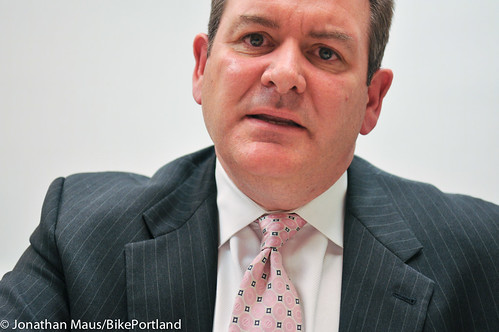
(Photos © J. Maus)
During the Oregon Active Transportation Summit last month, I had the opportunity to sit down with Matt Garrett, the director of the Oregon Department of Transportation. The main reason I requested the time with him was to learn more about the agency’s organizational shifts. Toward the end of our chat, I also asked him about a few other topics, like the Bike Bill, the Columbia River Crossing and the St. Johns Bridge, and more.
“So there’s a fight among the transportation sector. That’s not productive. If you’re going to have a healthy transportation sector, you have to be robust across all the portfolios.”
I’ll run this interview in two parts, with the first part focusing on the changes taking place at ODOT. Tomorrow I’ll publish part two, which will address those other topics.
Before sharing some transcripts, I want to say that interviewing Garrett wasn’t easy. The chat itself was enjoyable; but getting him to share candidly and directly about his perspective on where the agency is going, was a challenge. Anyone that has heard him speak might understand why. Garrett has the presence of a seasoned politician and he speaks in measured and broad brushstrokes. I also had quite a few mixed feelings about him going in.
The last time I exchanged more than pleasantries with Garrett was back in 2005 when he was a guest speaker at the Portland State University Traffic and Transportation Class I was sitting in on. At that time, Garrett was ODOT’s Portland region manager and I was still quite upset that under his leadership, they did not add sufficient bike access on the St. Johns Bridge when it underwent a multi-million dollar renovation. That heated exchange, my continued frustrations about the St. Johns Bridge, and Garrett’s recent drum-beating for the Columbia River Crossing highway expansion project bounced around my head with more recent thoughts of appreciation and excitement about a shift at the agency toward a less auto-centric approach.
Below are selected transcripts from our conversation…
“What we’re evolving to is trying to structure the organization as it’s articulated in the Oregon Transportation Plan. I’ve always tried to anchor back to our policy documents…
Left to our own devices, the way funding comes in, whether it’s federal or state, you’re siloed. And that’s the way the organization was structured and built up. It became a double-edged sword in a lot of ways. It restrains one from looking at a panoramic vision. You look at those policies that we’re supposed to be multi-modal, then you have Governor Kitzhaber coming in, reinforcing that, saying listen, you’re going to be mutli-modal.
The structure we had allowed us to do good things on the ground; but it was, in my mind, ad-hoc. Were we making a better system? Were the projects connected? We were siloed up. We had independent programs doing good stuff, but they weren’t working togeher. So structurally, we made the shift. The first step being the creation of the Active Transportation Section.
So, we’re going from a very rigid structure to one that is more comprehensive in making sure that we get all the voices of transportation around the table, including the internal voices here at ODOT. We’re moving out of the siloed approach to one that is more focused on function. So that’s the evolution. It will take time. It won’t come easy. There had been a little calcium that had been formed around the silos to be very honest with you. We’re moving to something that is a little more holistic. You have to be structurally ready to take it on, you have to have the policies in alignment and the third leg of that stool is the funding — and we’re working on all those fronts.”
“The first thing we’re doing is looking at the dollar and how much of that dollar is flexible [discretionary and not bound by law to be spent in a specific way]. Where can it go? We have very prescriptive constitutional language, so we have to play by those rules and that’s not going to change I don’t think. It would be a very bloody and it would be an unproductive battle — that’s the busting of the [Highway] Trust [Fund] conversation. Given that, we turn our attention to federal dollars, and what opportunity for flexibility do we have.
You saw a shift recently in creating $24 million in flexible monies that weren’t allocated to specific areas. That’s looking at what we already have. The question is, have we fully exhausted that conversation? I would submit to you that we have not. We’re going to bring that discussion to the OTC [Oregon Transportation Commission], saying, here’s the dollars we would classify as the most flexible and here’s where they’re allocated. That first $24 million was easy, because there was sort of a safe harbor, the money was already backfilled, so you didn’t have the camps rise up and no one was fighting each other for it — no one ox was going to get gored.
But the Commission now has in front of it, some other monies we share with cities and counties, that we invest in workzone safety, we’ll look at that itemized list and say, ‘Might you shift that?’ You might not want to, but you’ll have that flexibility. So I think that will be a very healthy and robust discussion… It offers an opportunity to grow the pie for some, but shrink the pie for others. So that really is an evolution of the flex fund conversation. The reality is that there’s not new money we can identify — it really is cutting the pie differently, so that creates tensions with different constituencies. There’s an opportunity to grow the pie specifically to active transportation investment; but it is probably going to cut the pie for someone else.”
“I knew we had individual programs that were scattered across the whole of the agency, not even in the same building at times…
I saw it [the lack of strategic investment] play itself out with the first round of the $24 million of flex funds. We had a lot of good projects; but they kind of just rippled across the whole of the state, so there was a sidewalk here, a little transit thing here… All good projects and I’m sure they made something a little bit better, but if you look at that and you have $24 million, if you had the right people around the table, informing the process and the mechanics, might you be able to target that and have a little more impact and create a little more of a network? Rather than 20-some projects that are kind of just splayed across the whole state? That really was the impetus for me to say, let’s bring these smart people in and make sure the collective wisdom is working.”
“A concern for me is we really have one piggy bank in the state of Oregon, and if people want more money, there’s only one piggy bank to go to… And in Oregon, that has to go to the roads; so you get the road gang saying, ‘No, no find other funds, this money is restricted.’ So there’s a fight among the transportation sector. That’s not productive. If you’re going to have a healthy transportation sector, you have to be robust across all the portfolios. So how do we remove that fight? We’re making an effort on many different fronts to see if we can identify new funding streams so we can grow opportunities for the non-roadway discussion. That’s real. We’ll see where it goes. It’s not going to be easy.
As for the naming of it, it’s to show that we’re changing — and it’s also to show that we’re trying to move out of the siloed approach that is dictated by the way we fund transportation… Let’s move from a ‘highway region’ to a transportation region and let’s embed all the pieces needed to answer the whole of the transportation question, rather than just saying, ‘I’m just going to talk about the roads, and how we maintain, preserve them, and than every so often we can surgically stripe and grow some opportunities [for active transportation], and begin to say, ‘Here’s the conversation we want to have and here are the resources I can bring in to inform that debate.'”
“I think Oregonians want that.”
“I think the federal government, at least on the Senate side, took a step in this direction with MAP 21. But yes, the strings are problematic.”
“If I could get rid of the strings… What I would suggest is, let’s focus on outcomes. A lot of this money comes with process; but let’s focus on outcomes. If we can agree that the outcome of this investment is X, and you allow me the local flexibility to do that, I will get you to this outcome. But don’t bind me by saying, ‘With this dollar you have to spend it in this specific area’. Instead, say, ‘With this dollar, you have to meet this outcome’… I think that would be healthier for the system and it certainly would allow each state to tailor their transportation portfolio to truly represent the need of its citizens.
Just think how much money we could leverage if we put all of the money in the bank and said, ‘Let’s look at this and see what we can do.'”
“I think each city is unique. They would have to cater to their citizens… You know, in my gut right now, again, I think the fiscal realities we all find ourselves in demand that we look at things differently… Is there an opportunity on a regional basis? Much like the Metro example, where everybody puts skin in the game and they help prioritize and are then looking at the system on the whole. That might be our future, Jonathan, to be very honest with you, and not only with transportation, but if you look at health care type issues, the clustering effect… might be an outcome of some of the fiscal challenges we’re seeing as a state right now.
The reality is, there are well over 300 different entities that have their fingerprint on either transportation policy or transportation funding. It probably is not the best recipe for efficiency to be very honest with you. So, if we could revisit that, if you assume that’s not the best structure, than what does the best structure look like? A collective whole which brings resource and capital to the table may better inform that. Than you can develop a system around the needs of your citizens.”
“What it does, is that it allows the voice to come to the table. It’s not drowned out, or hiding in the shadows of the big highway portfolio. But don’t get me wrong, the reality is, if you look at the expenditures in the highway portfolio, it is just taking care of the asset right now, it is preservation and maintenance, that’s who we are as an organization. But, what we want to make sure is, let’s take the next step. Let’s look at the different options that we have with the monies we have. And you’re seeing this debate start. Internally we’re making this shift, and the Commission is moving in this direction too. And what the Area Commissions on Transportation chairs will be asking is, ‘Do you have the right people sitting around the table to take on the issues? And more importantly, find the solutions and remedies?'”
“I think it’s mixed, especially as you head east [of the Cascades]. Some people celebrate it, they see where we’re going. Some people are saying, the proof’s in the pudding, and I think that’s more than fair.
What I think is productive about some of the feedback I’m getting is, well, if it really does animate [a word Garrett uses to explain the act of something come to fruition] it will allow us to develop our communities the way we want to.
I’ve had the privilege of working for this organization for 16 years now in different capacities; and I’ve traveled the whole of the state, and I will tell you, over the last several years, as I go east of the mountains, it used to be nothing more than, ‘Let’s preserve the highway, that is our lifeline!’ But over the last several years, I’m hearing, ‘Well, we need options, we need to get between point A and point B and I can’t drive, so is there some type of inner city bus service you can supply, or what about rail?'”
“I think it’s the latter… Well, it’s actually both to be very honest with you. But it’s time… You have to have certain things in place. You have to have the policy in place, you have to have the funding in place, you have to have the structure in place, and you have to surround yourself with the right people, be it internally or externally. And I think all these issues are now starting to come together, so I think it’s just a combination of everything that moves us in this direction.”
“Yes it is… That is exactly another transition that is taking place… We’re working on that, because I think one of the criticisms of this organization could be it always seems like a bike path was an afterthought. If you had money you kind of stuck it on at the end; but it was done at the 11th hour. Well now, integrate that in and ask, might the investment in this piece of infrastructure meet several different objectives, other than just a nice, safe and efficient roadway that would serve people as well as freight? Are there other commute options that you could embed in this piece of infrastructure?”
- In 2009, the Oregon legislature passed the Jobs & Transportation Act (HB 2001), which listed $800 million in transportation project earmarks — the vast majority of which were tradition, automobile-centric highway expansion and “modernization” projects. Garrett told me during the interview that only a few of those projects have been completed, some are in progress, and many won’t start for several more years.
“Absolutely, because you have projects that are really not mature, that are just a concept, you can embed this [new ODOT approach] into it very quickly. But what what the bill did, was put a specific dollar amount on the projects, and it put at times a specific terminus for the project. So you’ve gotta go back to the legislature [if you want to change a project significantly].
“I think you’re exactly right. Have that conversation up front. Just know, getting back to the rules of the game, with those earmarked projects, the funding is very prescriptive. But hypothetically, no, there’s no reason why you couldn’t look at one of those proposed solutions and say, ‘Let’s have a holistic discussion here, how do we make this investment more strategic?’ and if you can start to cobble together the funds…”
“Right, but if you want to do more…”
“Different is fine.”
“Right. It would just become part of the project. What I was saying is, the color of money is an issue here. The JTA [Jobs & Transportation Act a.k.a. HB 2001] projects are all paid for with Highway Trust Fund dollars, so you might have to bring additional monies, but that’s fine. But if you’re doing it right, you’ve got all those people at the front end of the discussion.”
— Read part two of this interview here.


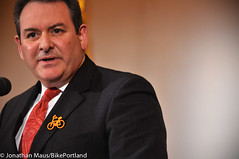

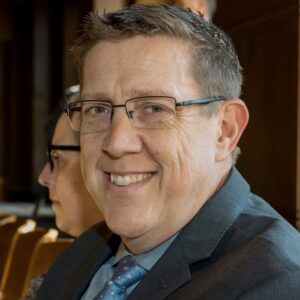
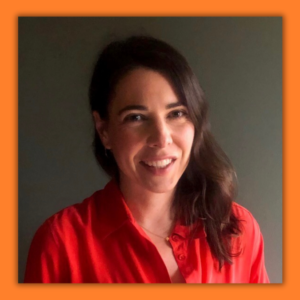
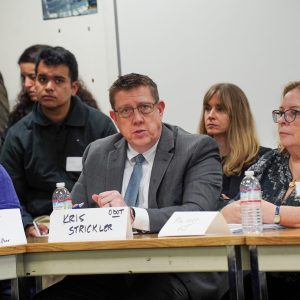
Thanks for reading.
BikePortland has served this community with independent community journalism since 2005. We rely on subscriptions from readers like you to survive. Your financial support is vital in keeping this valuable resource alive and well.
Please subscribe today to strengthen and expand our work.
Do you get in to questions about CRC funding in the second half?
It seems to me that ODOTs priorities should be as follows:
1) Maintenance of existing infrastructure
2) Safety projects, both auto and pedestrian/bike oriented. Removing dangerous road features, adding shoulders sufficient for safe cycling and auto-related emergencies. A 8ft shoulder is a great cycling facility and a safe place to pull over in emergencies. All roads should have these.
Hi Chris I,
I do ask him about the CRC in the next part. We don’t talk much about funding it though. Thanks for your comment.
I would like to see more dedicated statewide bicycle funding. Like maybe increasing the 1% set aside from the Oregon Bicycle Bill.
If it’s something we advocate for on the federal level, wouldn’t it make sense (and probably be easier) to do on the state level as well?
http://bikeportland.org/2012/03/22/oregon-advocates-check-in-with-senator-jeff-merkley-69295
“Back in November, Merkley offered up an amendment to the Senate transportation bill that would have dedicated 2% of surface transportation funding to bicycling and walking.”
OregonBicyclist,
We discuss this issue in the Part 2. Stay tuned tomorrow!
Wow. Rarely does one get to see so many cliche statements in a single person’s speech. Impressive:
Left to our own devices
It became a double-edged sword
good things on the ground
We were siloed up
the third leg of that stool
we have to play by those rules
there was sort of a safe harbor
the money was already backfilled,
so you didn’t have the camps rise up
no one ox was going to get gored.
an opportunity to grow the pie
we really have one piggy bank
everybody puts skin in the game
not the best recipe
have the right people sitting around the table
the proof’s in the pudding,
done at the 11th hour
Wow! It is clear that cliches do a great job of allowing Garrett to use lots of words and say almost nothing. Artful dodging.
Good job! Really!
You got some blood out of a turnip: where blood = information and turnip = politiReall
Information = politician.
Thanks Jonathan and Mr. Garret. I have to say I’ve had great response in calling ODOT and PBOT on issues in the last 2 years. Seems like they are more friendly.
Please more questions on
a) CRC
B) List of the 50 most costly road projects in Oregon every year for the last 10 years.
For example, one 2 mile stretch of MLK in SE cost $71 million to fix. It was very much over budget.
https://docs.google.com/open?id=1G8aej2geeXJ3DtkGguClsrLY9fTO67eKeaMS2Jq96IZzxu_0_ZAoe4C9FIbO
Am I reading what I want to read, or was this actually an interview with some pretty positive statements?
It’s great to read this from ODOT director Garrett. He talks a lot…does tend to go a bit overboard with, metaphors, catch phrases and the government lingo; I had to look up ‘siloed’ again to be sure of what he was probably talking about. In the case of monies in ODOT’s budget, siloed as Garrett was using it would probably mean money set aside, that the department is obligated to use for specific areas or projects.
Overall though…especially in the latter half of the portion of the interview posted in this bikeportland article, he sounds as if he knows what’s going on…that there are substantial changes occurring in the transportation needs of Oregonians, and that ODOT has got to change to be prepared to respond to those needs.
Well … at least they’re taking a small step which will over the years, hopefully, evolve into something more multi-model. It’s sounds like it’s going to take a long time to turn the machine, but perhaps now they are starting to listen to folks say, “turn the machine!”